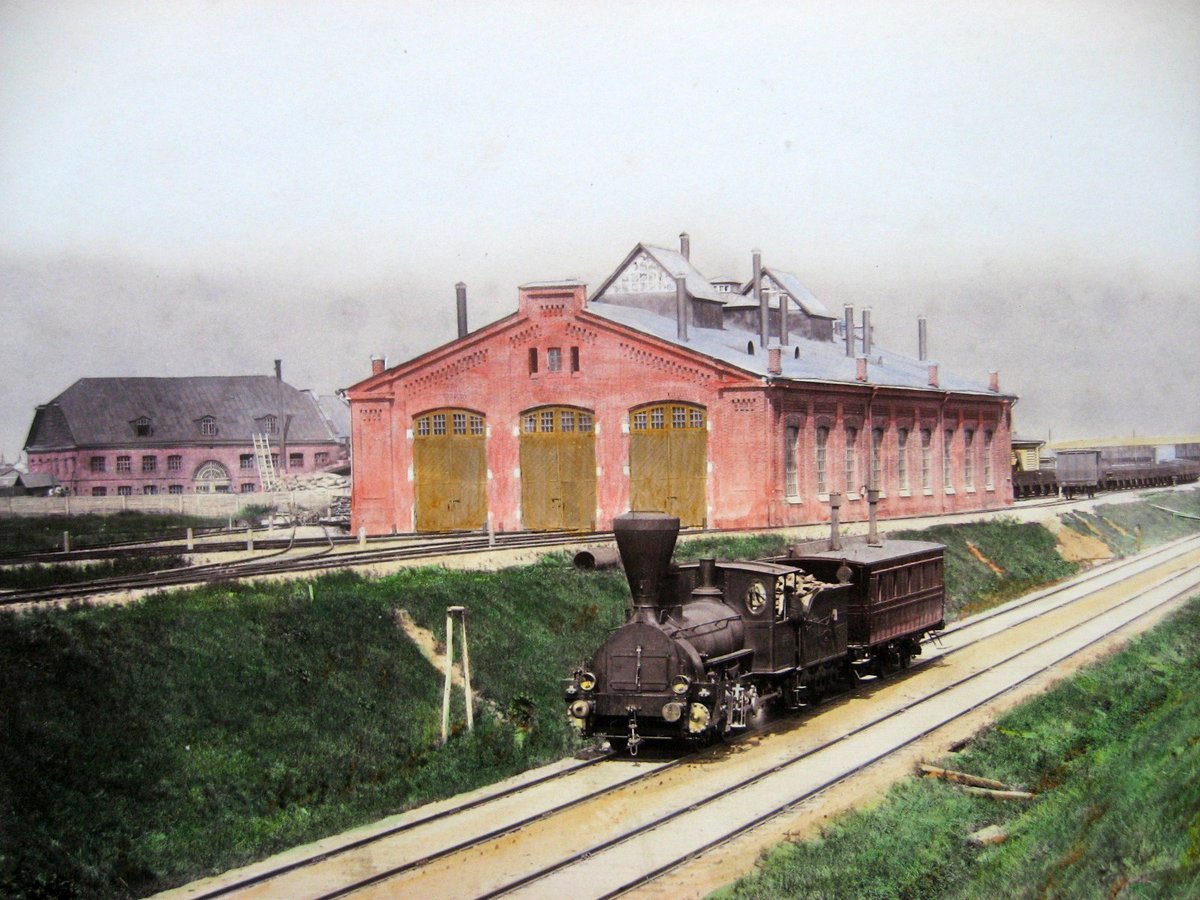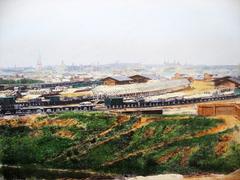
Moskva-Tovarnaya-Kurskaya: Visiting Hours, Tickets, and Guide to Moscow’s Historic Railway Hub
Date: 14/06/2025
Introduction
Moskva-Tovarnaya-Kurskaya, more widely known as Kursky Station, stands as one of Moscow’s most significant railway terminals—both a vital transportation hub and a living illustration of the city’s layered history. Established in the mid-19th century, the station connects Moscow to Russia’s southern regions and international destinations, blending imperial, Soviet, and contemporary architecture. This guide provides an in-depth look at Kursky Station’s historical evolution, visitor information, accessibility, nearby attractions, and practical travel tips, ensuring you make the most of your visit—whether as a commuter, tourist, or architecture enthusiast (Moscow Railway Stations: Kurskaya, Rusmania, Russian Trains).
Table of Contents
- Historical Background
- Architectural Features and Evolution
- Visiting Information
- Facilities and Services
- Transport Connections
- Nearby Attractions
- Practical Visitor Tips
- FAQs
- Sources and Official Links
Historical Background
Origins and Early Development
Kursky Station traces its origins to Russia’s railway boom in the 1860s, when the Moscow–Serpukhov line opened for passengers in 1866. The station was initially built outside the city limits and later extended to serve Tula and Kursk, forming an important corridor for both passengers and freight (Kursky suburban railway line). It was originally called Nizhny-Novgorod station, reflecting the experimental nature of early railways (Moscow Railway Stations: Kurskaya).
Industrial Significance, Expansion, and Modernization
As Moscow industrialized in the late 19th and early 20th centuries, Kursky Station became a critical freight and passenger hub, fueling urban growth. The current grand station, opened in 1896, reflected Moscow’s transformation into a modern metropolis. Electrification began in 1938, improving efficiency and enabling heavy suburban commuter flows (Kursky suburban railway line).
Integration with the Moscow Metro further elevated its role. The arrival of the Arbatsko-Pokrovskaya (1938) and Koltsevaya (1950) lines created seamless urban connections (UrbanRail Moscow), making Kursky one of the city’s busiest interchanges.
Wartime and Contemporary Developments
During World War II, the station was vital for troop and supply movements. Postwar renovations and the introduction of the Moscow Central Diameters (MCD) in 2019 further enhanced connectivity and capacity (Kursky suburban railway line).
Architectural Features and Evolution
Historic and Modernist Influences
Kursky Station’s design blends imperial grandeur with Soviet modernism and contemporary glass facades. The original masonry structure was renovated in 1938 and dramatically modernized in 1972, when a striking glass façade and roof were added (Wikipedia).
Recent and Planned Upgrades
Natural light now fills the concourse, and ongoing upgrades focus on passenger comfort and safety, including accessibility enhancements and platform refurbishments to meet modern standards (Wikipedia).
Urban Integration
Centrally located near Kurskaya and Chkalovskaya metro stations, the terminal is connected by underground passages and vestibules, streamlining transfers to various city districts (RailwayTraveller, Mapcarta).
Visiting Information
Visiting Hours
- Station: Open 24/7 year-round.
- Ticket Offices: Generally operate from 5:00/6:00 AM to 11:00 PM or 1:00 AM.
- Self-Service Kiosks: Available 24/7.
Ticketing
- Where to Buy: Tickets for suburban and long-distance trains are available at ticket counters, kiosks, and through official online platforms (Russian Railways official website).
- Payment: Both cash and cards are accepted, though some restrictions may apply to foreign cards (Miss Tourist).
- Troika Card: Recommended for metro and ground transport; offers discounted fares (Russiable).
- Advance Booking: Advised for high-speed trains and peak travel periods.
Accessibility
- Station: Ramps, elevators, tactile paving, and accessible restrooms are provided.
- Metro Links: Connected stations are similarly equipped for accessibility (Russiable).
- Assistance: Available upon request; children under 7 travel free with an adult on metro/suburban trains.
Security and Boarding
- Procedures: All passengers must pass through security checkpoints with baggage scanning.
- Timing: Arrive at least 30–40 minutes before departure for smooth boarding (Russian Trains).
Facilities and Services
- Platforms: 9 platforms, 17 tracks; over 300 daily departures (Russian Trains).
- Waiting Areas: Regular and premium lounges.
- Luggage Storage: Secure left luggage for hourly or daily use.
- Food & Shopping: Cafés, restaurants, and shops in the terminal and adjacent Atrium Shopping Mall (Russian Trains).
- WiFi: Free throughout the station.
- ATMs & Exchange: Widely available, but carry cash as a backup.
Transport Connections
Metro
Direct access to three metro lines:
- Line 3 (Arbatsko-Pokrovskaya, dark blue): City center.
- Line 5 (Koltsevaya, brown): Connects major terminals.
- Line 10 (Lyublinsko-Dmitrovskaya, light green): Northeast/southeast Moscow (Russiable).
Surface Transport
- Buses, Trams, Trolleybuses: Multiple routes serve the station.
- Suburban Trains: Depart toward southern and eastern Russia.
- Taxis/Ride-Sharing: Use official apps like Yandex.Taxi.
Nearby Attractions
- Zaryadye Park: Panoramic city and Kremlin views, easily accessible by metro.
- Red Square & Kremlin: Quick metro ride from Kursky.
- Nearby Districts: Basmanny and Tagansky offer historic architecture, museums, and trendy cafes (Mapcarta).
- Atrium Shopping Mall: Directly linked for shopping and dining.
Practical Visitor Tips
- Visit during off-peak hours (mid-morning or late evening) for fewer crowds.
- Use the Yandex Metro app for offline navigation.
- Carry your passport and visa due to occasional police checks.
- Keep cash handy; not all vendors accept foreign cards.
- Watch belongings to avoid pickpocketing.
- Guided walking tours are available for the surrounding historic district.
Frequently Asked Questions (FAQs)
Q: What are Kursky Station’s visiting hours?
A: The station is open 24/7; ticket offices generally operate from 5:00/6:00 AM to 11:00 PM or 1:00 AM.
Q: How can I buy train tickets?
A: At ticket offices, self-service kiosks, or online via official websites and apps.
Q: Is Kursky Station accessible for disabled travelers?
A: Yes, with elevators, ramps, tactile paving, and accessible restrooms.
Q: Are guided tours available?
A: The station itself does not offer official tours, but city tour operators often include Kursky in their itineraries.
Q: Where are the best photo spots?
A: The main façade, the glass tunnel to Atrium Mall, and the platforms at sunrise or twilight.
Conclusion
Moskva-Tovarnaya-Kurskaya, or Kursky Station, is much more than a transport hub—it is a living monument to Moscow’s evolving identity. Its fusion of architectural styles, strategic location, and robust connectivity make it an essential stop for travelers and a gateway to exploring the Russian capital. By understanding its facilities, transport links, and cultural context, you’ll enhance your Moscow experience, whether passing through or embarking on a city adventure.
For the latest updates, travel tips, and digital resources, download the Audiala app and follow us on social media. Explore our dedicated guides for more on Moscow’s railway heritage and travel inspiration.
Sources and Official Links
- Moskva-Tovarnaya-Kurskaya: A Historical and Visitor’s Guide to Moscow’s Iconic Kursky Railway Station, 2025 (Moscow Railway Stations: Kurskaya)
- Visiting Moskva-Tovarnaya-Kurskaya: A Comprehensive Guide to Moscow’s Historic Transport Hub, 2025 (Rusmania)
- Kursky Railway Station Moscow: Visiting Hours, Tickets, and Travel Guide, 2025 (Russian Trains)
- Moscow Kursky Railway Station: Visiting Hours, Tickets, and Cultural Insights, 2025 (Wikipedia)
- Kursky suburban railway line, 2025 (Kursky suburban railway line)
- UrbanRail Moscow, 2025 (UrbanRail Moscow)
- Polis Network, 2021 (Polis Network)
- HowToRussia, 2025 (HowToRussia)
- Mapcarta, 2025 (Mapcarta)





















































































































































































































































































